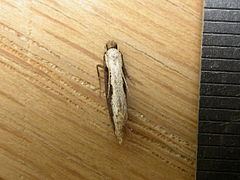Scientific name Erechthias Rank Genus | Subfamily Erechthiinae Higher classification Erechthiinae | |
 | ||
Similar Butterflies and moths, Tineidae, Erechthias minuscula, Insect, Opogona | ||
Erechthias is a genus of the fungus moth family, Tineidae. Therein, it belongs to the subfamily Erechthiinae, of which it is the type genus. The exact circumscription of this genus is still disputed, but it may encompass more than 150 species.
Contents
Systematics and taxonomy
Here, the genus is treated in the wide circumscription (sensu lato) adopted by many authors today, and representing the presumed core group of the Erechthiinae. Delimited thus, Erechthias includes several other genera, some of which have occasionally been treated as independent even by fairly recent authors. They are still rather similar and contain moths that are (at least overwhelmingly) very closely related. Still, they differ in details such as the wing venation – with Erechthias sensu stricto having all veins separate (as opposed to e.g. the Decadarchis group, which has hindwing veins 5 and 6 stalked) – or the clasper's harpe being nude in Erechthias s.str. but bearing a cluster of setae on the costa. However, the female genitals look almost alike in all of them.
Many of these supposedly distinct genera were always considered monotypic and are unlikely to be valid. More notable are Decadarchis (including Caryolestis, Nesoxena, Pantheus and perhaps others) and Ereunetis (including Lepidobregma and Neodecadarchis); these two are more frequently considered separate genera than other subgroups of Erechthias. The members of the former (sub)genus were in fact at first often placed in Tinea of subfamily Tineinae. Other species of Erechthias were historically assigned to Acridotarsa – also of the Tineinae (E. deloneura) – or to Mesopherna of the Myrmecozelinae (E. epomadia). E. glyphidaula has been a particular source of confusion; even veteran researcher Edward Meyrick, in some of his last works, no less than three times established a new monotypic genus for this species.
More unusually, some species of Erechthias were initially mistaken as members of the cosmet moth genus Cosmopteryx (E. cyanosticta) and the ermine moth genus Argyresthia (E. zebrina); these genera are basal Ditrysia not particularly closely related to Erechthias. The enigmatic "genus" Acrocenotes – a single species initially held to belong in the Plutellidae, which are also not close relatives of Erechthias – is also included here in the present treatment.
As another taxonomic curiosity of this genus, E. beeblebroxi is named after Douglas Adams's famous two-headed science fiction character Zaphod Beeblebrox; the moth has a "false head" pattern that presumably helps to confuse would-be predators.
Finally, the actual delimitation of Erechthias against related genera such as Comodica still needs to be determined. For example, whether the Erechthiinae Callicerastis stagmatias and Mecomodica fullawayi are justifiably separated in their monotypic genera or better included in Erechthias (as are all the other species once placed in Callicerastis) is disputed; the latter in particular seems to be somewhat intermediate between Comodica and Erechthias.
Selected species
The numerous species of Erechthias include:
Synonyms
Times and again, groups of these moths have been proposed for separation in distinct genera. These junior synonyms of Erechthias, in the circumscription used here, are:
